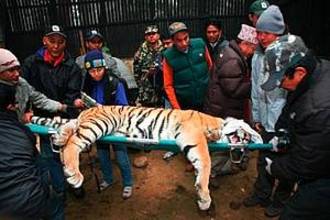Nepal translocates first wild tiger
A wild tiger fitted with satellite-collar was successfully translocated from Nepal's Chitwan National Park to Bardia National Park for the first time on Saturday.
|
The wild tiger being transferred to its cage after it was collared before translocation to Bardia National Park. Chitwan National Park, Nepal. 21 Jan 2011. [WWF] |
The translocation was led by the Government of Nepal with support from WWF Nepal and the National Trust for Nature Conservation during the last days of the Year of the Tiger. It will further Nepal's goal of doubling wild tiger numbers by 2022, the next time the Chinese calendar celebrates the endangered species.
"This translocation—the first of its kind in Nepal—is a concrete example of our commitment to saving wild tigers using the best science available, including the application of cutting-edge technologies," said Minister of Forest and Soil Conservation of Nepal, Deepak Bohara. "I am confident that by working together the global community can reach the goals we set ourselves at the recently concluded tiger summit to save tigers to benefit people, nations and nature."
A pioneering move
The wild tiger was an injured male captured by park authorities from Chitwan National Park after it wandered into the premises of a hotel in the tourist town of Sauraha outside the park in September last year. The tiger was placed in a secure enclosure at the park's headquarters for treatment where it recovered completely.
On Friday, a team of wildlife veterinarians, wildlife biologists, park staff and conservationists tranquilized the tiger and fitted it with a GPS plus GLOBALSTAR-3 satellite collar. It then was transported by road about 600 km in a specially constructed trailer from Chitwan National Park westwards to Bardia National Park under strict supervision and security measures. The tiger was finally introduced to its new home in the fertile valley along the River Babai on Saturday.
"The Babai valley was an ideal location for the translocation because of its vast size and available prey species, improved anti-poaching efforts, lower human-tiger conflict and good connectivity with other protected areas through the Terai Arc Landscape all the way to India's Suhelwa Wildlife Sanctuary," said Krishna Acharya, Director General of Department of National Parks and Wildlife Conservation. "Nepal is one of the countries in the world where the prospect of doubling the tiger population is quite good, if tigers are given enough space, prey and proper protection."
The satellite collar, which gives an accurate location of the tiger every half-hour, will help scientists gain a better understanding of tiger ecology, improve conservation interventions like anti-poaching operations and monitor the tiger adapting to its new environment.
"WWF is pleased to have played a part in the pioneering tiger translocation led by the Government of Nepal," said Anil Manandhar, WWF Nepal's Country Representative. "As a global conservation organization, we have been part of the Nepal's evolving conservation landscape—from species protection to the successful Terai Arc Landscape—for over four decades, and remain committed to working together with our partners to help save nature for future generations."
 0
0 








Go to Forum >>0 Comments